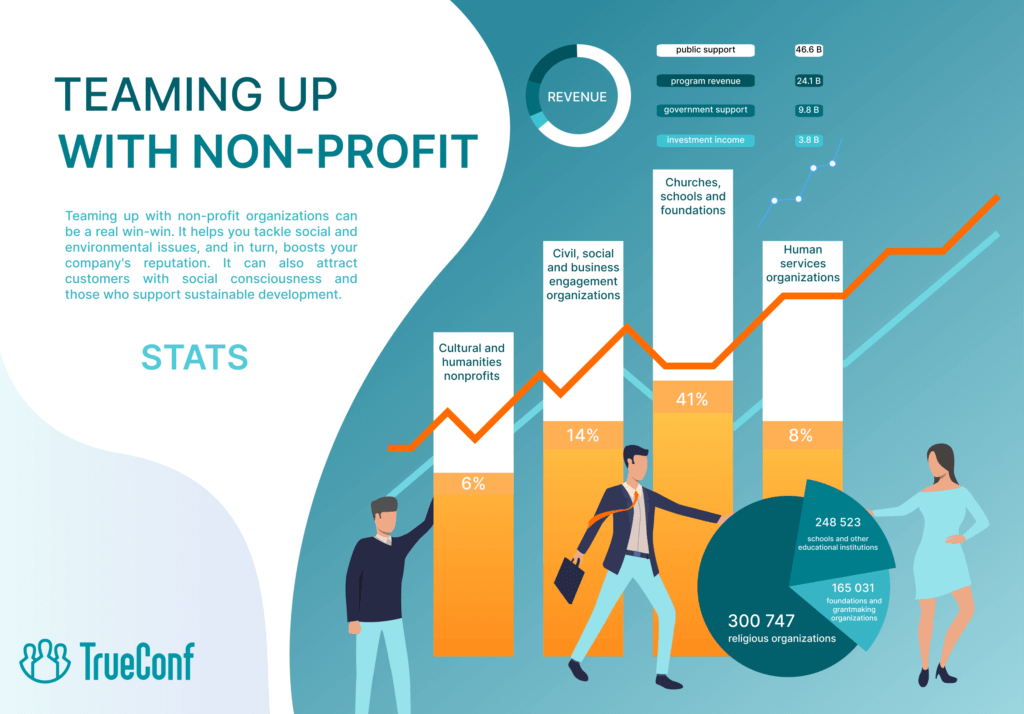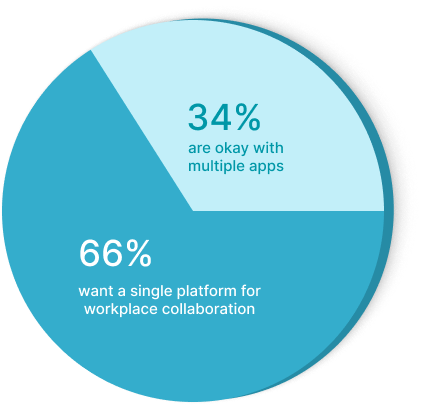What is Business Collaboration?
Business collaboration is about making connections in and out of your company to spark creativity, tackle problems, and hit those shared targets. The recipe for successful collaboration is simple – be open, honest, and productive in your communication, so everyone wins!
Covid-19 has pushed remote collaboration forward, thanks to less face-to-face meetings. And lots of businesses are ready and up for this change, as working from the comfort of one’s home can make us happier, save us money, and even level up our productivity.
Digital tools or solutions have been instrumental in making remote work a breeze, showcasing that teamwork can thrive regardless of our physical location. Whether we’re collaborating across the office or across continents, these tools have revolutionized how we approach tasks and projects. From video conferencing platforms to collaborative document editors and business process management tools, the key takeaway is that distance doesn’t diminish the passion and dedication we bring to our work.
And business collaboration isn’t just about your in-house team. Many businesses are making friends with other companies, clients outside their organization to hit shared goals and come up with fresh ideas. Collaborating with external partners can also help you validate business idea concepts more effectively, since you gain diverse insights and feedback before moving forward. So, when you’re thinking about business collaboration, remember to look beyond your team and consider joining forces with those outside your company walls, too.
These types make up the overall collaboration:
- Business collaboration: a key aspect of outbound lead generation where companies join forces to share resources, knowledge, and skills. This results in new products, improved efficiency, and a wider market reach. It can usually be achieved by using email outreach tools, mutual connections, or networking events.
- Academic collaboration: when companies and academic institutions team up, knowledge and research get shared. This collaboration not only leads to innovative solutions and transforms academic research into real-world products but also provides opportunities for practical learning.
- Government collaboration: help from the government can be presented to your team through things like funding programs, setting up rules, or even providing platforms for collaboration.
- Non-profit collaboration: teaming up with non-profit organizations can be a real win-win. It helps you tackle social and environmental issues, and in turn, boosts your company’s reputation. Organizations not only maintain meaningful connections with their constituents but also optimize operational efficiency and donor engagement through cutting-edge CRMs for nonprofits or donor management software.

Each type of collaboration is like a unique flavor, each with its own importance and benefits. Real-world examples, such as those found in marketing case study collections, demonstrate how different collaboration approaches lead to tangible results. This can level up innovation, toughen up resilience, and ultimately, pave the way to success in the interconnected world we live in. Starting a business requires patience, persistence, and time.
Let’s talk more about the first type. What is it? Business collaboration!
Forms of Business Collaboration
Internal Collaboration
Internal collaboration is about teams within the same company bonding together to tackle a task or brainstorm ideas. It’s like a place, where everyone brings something different to the table across all departments. The beauty of internal collaboration is in its power to build a solid team spirit as well as open and friendly atmosphere. That helps completing projects or reaching shared goals. And the best part is that what is shared stays within the team, keeping any confidential info within an organization. To get a clearer understanding of your team’s ongoing morale, it makes sense to conduct regular internal pulse surveys.
Internal collaboration within a company takes many forms, from partnering with colleagues on shared projects to the opportunity to seek wisdom from seasoned team members who bring years of experience and valuable insights to guide your professional growth. Think of it like setting up a cozy online lounge or a self hosted chat server where employees and leaders can share updates, knowledge, and insights about the company. It’s a great way to keep everyone in the loop and make everyone feel like part of the team.
External Collaboration
External collaboration is all about reaching out beyond your company’s walls for projects or valuable insights on how things are done. By using external collaboration, you can level up your business processes, like collecting feedback from customers on a particular product line or co-creating visual assets using tools such as a logo maker to ensure consistent branding across partnerships..
There’s a few ways to collaborate with the outside world, for example, chatting with customers directly or sending them an email. A great way to do this could be asking customers for their thoughts on a product or service through an email survey. The insights gathered can then be used for customer experience research to make improvements.
Strategic Alliances
Strategic alliances are formal agreements between two or more independent organizations that agree to collaborate to achieve shared objectives while remaining legally and operationally separate. These alliances allow companies to pool resources, expertise, or market access to achieve outcomes they might struggle to reach individually. For example, one company might contribute technological expertise — such as revenue recognition software — while another offers strong distribution networks. Unlike mergers or acquisitions, strategic alliances maintain the autonomy of each party, making them a flexible and low-risk way to pursue growth, innovation, or international expansion.
Take big pharma companies, for example. They’ve successfully built dream teams by partnering with smaller biotech firms. This strategy lets them get their hands on intellectual property rights, research paths, or specific drug candidates. In return, these smaller biotech firms get to use the big companies’ resources, infrastructure, and expertise. This partnership allows them to step up their game and compete more effectively in their markets. So, it’s a win-win for everyone!
Strategic alliances aren’t always about flashy partnerships or big joint ventures — sometimes, they look like strong, long-term relationships with suppliers. In many cases, what starts as a basic transaction can over time grow into a collaborative partnership built on trust, shared goals, and transparency.
Joint Ventures
Joint ventures are collaborative business arrangements where two or more companies come together to form a new, jointly-owned entity to pursue specific objectives. Each partner contributes resources such as capital, technology, or expertise, and shares in the profits, losses, and control of the venture. Unlike looser forms of collaboration, a joint venture typically involves the creation of a separate legal entity distinct from the participating organizations, with its own management structure and operational strategy.
This type of collaboration is often used when companies want to enter new markets, develop new products, or share the financial risk of large-scale projects. For instance, in the digital space, joint ventures can be formed to accelerate mobile app monetization, combining one partner’s user base or platform with another’s content or advertising network. Joint ventures offer the advantage of uniting complementary strengths while distributing responsibilities and costs. However, they require clear agreements, aligned strategic goals, and strong governance to avoid conflicts and ensure sustained success.
Network Collaboration
Network collaboration is when individuals join in to chase their personal dreams. It can happen in person or online, and often brings together people who might not have crossed paths before. Whether it’s through professional communities or blogs, individuals can share knowledge, exchange ideas, and gain insights that drive personal and career growth. Everyone in this collaboration brings their unique perspectives or experiences to the table. Over time, it’s expected that people make new friendships as well as professional contacts to help reach their goals.
Automation tools have transformed the landscape of network collaboration, granting both businesses and individuals the ability to enhance their communication endeavors significantly. These versatile solutions take care of the tedious tasks, such as sending emails, engaging on social media, and follow-ups, enabling you to achieve more with minimal effort. Furthermore, these tools often provide valuable insights and Business Analytics, allowing you to refine your outreach strategies for optimal impact. The ultimate aim of network collaboration is to provide everyone in the network with helpful resources so that people bring something valuable to the table!
Cloud Collaboration
Hasn’t working together in person become a thing of the past? Cloud collaboration is on the rise and it’s all because of the amazing flexibility and broad usage it offers. The survey from McKinsey says 80% of businesses are now using collaboration apps in their operations.
And it’s not just about working together on the same project, it’s also about automating the daily tasks, like budget requests. They sync up perfectly with crucial business applications for swapping data. The best part is making all the important info easily accessible to everyone, no matter the department or project. Such apps let you chat instantly, all while knowing your company’s data is safe. They also offer a level of flexibility not seen before, so long as they are combined with appropriate third party tools, which are offered to all stakeholders.
Marketing Collaboration
Collaborative marketing is when companies become a single force in order to pull off some really awesome marketing strategies. A key step is presenting a unified and recognizable brand image. Whether you’re partnering on a campaign or co-launching a product, a memorable logo helps create a lasting impression.
What’s so great about this? Well, when companies team up, they can really play off each other’s strengths to take their marketing effectiveness to the next level. And this lets them reach more people, get their brand noticed, find new customers, and acquire more leads.
Remember when Uber and Spotify joined forces? You get in an Uber, connect your Spotify, and play your favorite tunes during your ride. Not only does this make your ride more fun, it gives both Uber and Spotify a ton of exposure and makes them look amazing.
In many of today’s collaborations, especially in the digital space, partners also integrate powerful inbound marketing software to streamline content creation, lead nurturing, and performance tracking. These tools help ensure that campaigns reach the right audience with personalized messaging, automate follow-ups, and provide valuable insights into user behavior. By combining creative marketing ideas with advanced technology, companies can build more engaging, data-driven campaigns that deliver measurable results.
Outsourcing and Freelance Collaboration
Outsourcing and freelance collaboration involve delegating specific tasks or functions to external individuals or agencies rather than handling them in-house. These team-ups allow businesses to access specialized skills, scale operations quickly, and reduce overhead costs. Freelancers typically work on a project or contract basis, offering flexibility and expertise without the long-term commitments of full-time employment. Outsourcing, on the other hand, often involves hiring third-party firms to manage entire processes such as customer support, software development, content creation, or accounting.
These forms of collaboration are especially valuable for startups and small businesses that need to stay agile and cost-efficient. They enable companies to focus on their core competencies while leveraging global talent pools for non-core or technical functions. To maximize efficiency and reach, many teams also incorporate automation tools for outreach, streamlining communication with clients, leads, or partners. With the rise of remote work platforms and digital project management systems, coordinating with freelancers and outsourced teams has become more transparent, scalable, and effective. However, success still depends on clear communication, defined expectations, and strong quality control.
Supply Chain Collaboration
Supply chain collaboration refers to the strategic coordination between companies involved in the production and distribution of goods or services—such as suppliers, manufacturers, logistics providers, and retailers. The goal is to improve efficiency, reduce costs, and enhance responsiveness to market demands by sharing information, aligning processes, and making joint decisions. This collaboration can include activities like demand forecasting, inventory management, production planning, and delivery scheduling, often supported by shared digital platforms, the best accounting proposal software for streamlined financial coordination, and real-time data exchange.
In today’s interconnected markets, effective supply chain collaboration is essential for maintaining competitiveness and resilience. For e-commerce brands, print on demand solutions play a key role in this process by managing product customization, fulfillment, and shipping, allowing businesses to stay lean while scaling efficiently. Businesses increasingly rely on integrated systems and automation tools to manage procurement, track shipments, and monitor supplier performance. Additionally, SaaS marketing agencies often play a role in optimizing visibility and brand coordination across the supply chain, especially in B2B and e-commerce ecosystems. By fostering transparency and trust among all parties, companies can reduce lead times, respond faster to market changes, and create a more agile and data-driven supply chain.
Technology-Based Collaboration
Technology-based collaboration involves the use of digital tools and platforms that enable teams to work together efficiently, regardless of physical location. These technologies support real-time communication, file sharing, project management, and collaborative decision-making. These technologies support real-time communication, file sharing, project management, and collaborative decision-making. Add: Businesses can find a wide range of these collaboration tools on a software marketplace, where they can compare features and pricing to find the best solutions for their needs.Common tools include video conferencing platforms, shared document editors, messaging apps, and cloud-based project trackers. Whether used for internal coordination or cross-organizational efforts, these tools significantly enhance workflow efficiency, reduce manual overhead, and keep everyone aligned on goals and deadlines.
With the rise of remote and hybrid work models, technology-based collaboration has become essential to modern business operations. Companies rely on platforms like Slack, Microsoft Teams, and Google Workspace to stay connected. For organizations with strict data security requirements, on-premise unified communications solutions such as TrueConf provide a secure alternative, ensuring full control over infrastructure and communications. In more technical environments, such as AI and data science teams, integrating MLOps observability tools allows for better monitoring, collaboration, and governance across machine learning workflows.
Benefits of Business Collaboration
- Employee engagement: engaged employees actively contribute to their teams and company. A collaborative workplace motivates engagement, leading to better productivity and customer satisfaction — especially when feedback is regularly gathered using well-designed survey templates.
- Learning and skill development: collaboration allows employees to learn from each other organically, expanding their collective skill set. This helps in effectively solving new challenges.
- Workflow efficiency: collaboration can level up problem-solving, making production faster and more efficient. It encourages open communication, ensures even workload distribution, and reduces workplace stress.
What is TrueConf Collaboration Role in Business?
Upgrading your business collaboration with software like TrueConf is way easier than you might think. The solution has customizable public and private channels, just like your favorite messaging apps, but it’s all neatly packed into the TrueConf app. It works for any type of business.
Each team member can jump into groups, and they can choose whether to get notifications for each chat. This keeps everyone in the know and in line with the company’s plan. When you’re working on a specific project, all the chat happens right in the relevant group.

Don’t let messy data and confuse communication. When you manage your info strategically in a collaborative environment, it’s adding fuel to your business. Did you know that 66% of employees are willing to have a single platform for workplace collaboration to cut out the chaos? It’s time to make a change. Make business collaboration a breeze with TrueConf.
Take your team communication to the next level with TrueConf!
A powerful self-hosted video conferencing solution for up to 1,000 users, available on desktop, mobile, and room systems.
About the Author
Nikita Dymenko is a technology writer and business development professional with more than six years of experience in the unified communications industry. Drawing on his background in product management, strategic growth, and business development at TrueConf, Nikita creates insightful articles and reviews about video conferencing platforms, collaboration tools, and enterprise messaging solutions.





Follow us on social networks